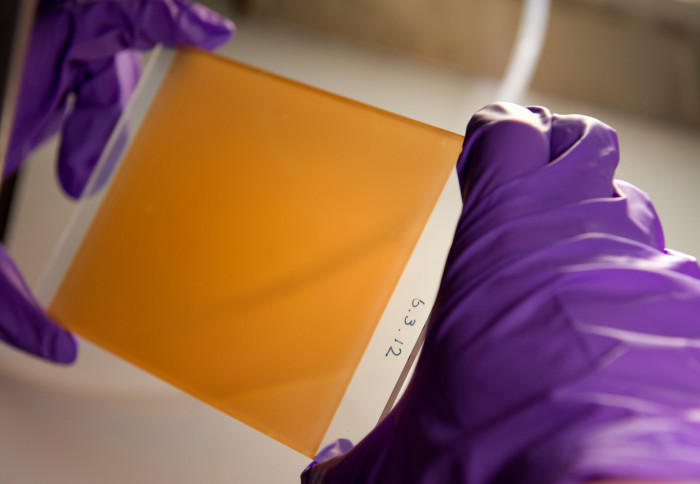
Picture showing a photoelectrode for use in solar fuel production: Imperial College London

Analysis from Imperial College London will improve the characterisation of photoelectrodes used in the production of solar fuels.
Researchers in the Department of Chemical Engineering at Imperial College London have discovered that well-established characterisation methods for photoelectrodes produce uncertain results, limiting the efficiency of solar fuel production techniques. Their findings could greatly improve the understanding and performance of materials used for producing renewable solar fuel.
The research has been published in the Journal of Materials Chemistry.
Storing for the future
Solar fuels have the potential to be a very useful renewable energy source, as they convert solar energy into chemical energy, using common substances like water and carbon dioxide. This means that solar energy can be harvested in summer months and stored as chemical energy for use later in the year, when there is less sunlight.
In order to improve the functionality of solar fuels, researchers need to understand the materials that are used to make them, so that they can make production processes more efficient. But the established characterisation methods for these materials have been producing uncertain results.
Solar fuels are produced in photoelectrochemical reactors, which combine the functions of a normal photovoltaic cell and an electrolyser into a single device. Photoelectrochemical reactors contain materials called photoelectrodes, which are able to simultaneously absorb light and accelerate or “catalyse” the water-splitting reactions that produce hydrogen fuel from water.
By exploring the various different techniques used for characterisation of photoelectrodes, researchers have been able to understand the problems faced today in characterising photoelectrode materials, and to make recommendations of how best to avoid these problems.
A nano-problem
Current research in photoelectrode development is focused on finding new materials and material structures with greater chemical stability and ability to catalyse water-splitting reactions.
A set of techniques known as “nano-structuring” is being used to modify photoelectrodes to make them more efficient at producing solar fuels from sunlight. Nano-structuring techniques are used to modify the structure of the material on the nano scale, in order to improve charge transport properties, absorption of light, and the rate of chemical reactions.
Electrochemical measurements are used to characterise new materials in order to better understand their chemistry, but there are challenges with characterising these nano-structured materials.
Principal Researcher Dr Anna Hankin explained: “Photoelectrode characterisation data has historically been interpreted using over-simplified models, meaning that some of the derived parameters that are used to describe material performance are unreliable. The over-simplified calculations lead to a large range of values being obtained for the same parameter, instead of a single accurate value.”
It has been particularly difficult to calculate the flat band potential, which is one of the key parameters used in the evaluation of photoelectrode performance. This is a problem because the accuracy of the flat band potential’s value is essential in forming models to describe and predict photoelectrode performance.
A six-year solution
This research reviewed data all the way back to the early developments of photoelectrode material characterisation from the 1970s, and analysed all assumptions that were made to determine whether they were responsible for the over-simplification of the models.
In particular, researchers found that the Mott-Schottky characterisation method, which is often used to study semiconductor-liquid interfaces for photoelectrochemical energy conversion, produces inaccurate results.
Dr Hankin said: “We generated models of what experimental data should look like on our materials, if all the assumptions were applicable. Comparison between our experimental data and predictions showed huge discrepancies.”
This work took a staggering six years to complete. Researchers had to ensure they had analysed enough experimental data, so they could be certain that well-established approaches should not be used for photoelectrochemical characterisation. They also had to be certain of why results varied when different techniques were used.
Dr Hankin added: “In the end, perseverance paid off and we were able to reconcile all our results and observations."
-
'Flat band potential determination: avoiding the pitfalls' byAnna Hankin, Franky E. Bedoya-Lora, John C. Alexander, Anna Regoutz and Geoff H. Kelsall, published 8 November 2019 in Journal of Materials Chemistry A.
Article text (excluding photos or graphics) © Imperial College London.
Photos and graphics subject to third party copyright used with permission or © Imperial College London.
Reporter
Lily Shepherd
Department of Chemical Engineering

Contact details
Email: press.office@imperial.ac.uk
Show all stories by this author


